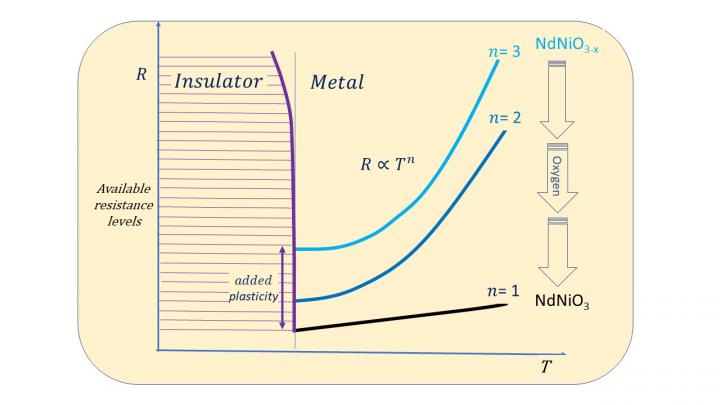
Credit: Beatriz Noheda, University of Groningen
Some metal oxides, such as nickelates, have a tuneable resistivity, which makes them an interesting material for adaptable electronics and cognitive computing. These materials can change their nature from metallic to insulating. How exactly this metal-insulator transition takes place is a topic of great interest in condensed matter physics. However, even the metallic behaviour in nickelates seems unusual. Scientists from the University of Groningen, together with colleagues from Spain, have now found that it is not as complex as was previously assumed. The results were published on 11 June in the journal Nature Communications.
In a metal, electrons can move freely, whereas in insulators, they are strongly localized around the atomic nuclei. When a metal is heated, the ions’ vibrations (called phonons) scatter the moving electrons and increase the resistivity. In contrast, heating can generate conductivity in some insulators, when electrons receive enough energy to be released and cross the energy band gap that otherwise prevents them from moving.
Exotic explanations
‘In some oxides, such as nickelates, a transition from insulator to metal can occur but it is not clear how this happens,’ says Beatriz Noheda, Professor of Functional Nanomaterials and Director of the Groningen Cognitive Systems and Materials Center (CogniGron) at the University of Groningen. She and her PhD student Qikai Guo are interested in nickelates because it is possible to tune their resistivity. They could be used in devices that emulate the way that synapses in our brain work.
‘Before we can do this, we should understand what the nature of the simplest state, the metal state, is. This means understanding how electrons move around in the material when an electric field is applied to them,’ explains Noheda. A linear change in resistivity (an exponent of 1 in the curve that represents the resistivity as a function of temperature) can be explained by a simple model in which the electrons are impeded by the vibration of the ions. ‘However, for an exponent that is not 1, more exotic explanations have been suggested, based on the presence of fluctuations in the spins of the nickel electrons and electron-electron interactions that occur when the system is close to a quantum critical point.’
Strain
However, in thin films of neodymium nickelate (NdNiO3), Noheda and her team observed that the exponent was 1 in some samples, while in other samples of the same material, it was not. This suggests that the exponent is not an intrinsic property. Noheda: ‘That led us to systematically look at samples grown on different substrates.’ The results showed that in perfect films, the exponent is 1, which means that the resistivity is caused by phonons, as it is in normal metals. However, when the substrate that is used induces strain in the thin film, the exponent changes.
The strain leads to oxygen vacancies in the crystals and changes the forces between the ions and, therefore, the electronic energies. That, in turn, changes the materials’ resistivity. ‘What we found out is that we can control the number of vacancies and continuously tune the resistivity exponent at will, which is a tuning knob that we did not know we had. Thus, understanding the metal state in these nickelates may not require exotic electron-electron interactions,’ Noheda concludes.
Synaptic devices
Learning how to control the metal state and the transition to the insulator state will help scientists to design electronics based on nickelates, which can emulate the way that neurons work. That is the ultimate goal of Noheda and her team. ‘We now know that these nickelates are more similar to normal metals than we previously thought. This means that they can be quite good conductors if we ensure that there are no ion vacancies in the crystal. In this way, the transition to the insulating phase brings about larger changes in resistance, leading to synaptic devices with improved plasticity.’
In these experiments, the change in resistivity in these nickelates was induced by an increase in temperature. ‘This is of course not ideal when you want to make a device. Our next step is to design the material in such a way that we can tune resistivity using an electric field,’ Noheda concludes.
###
Simple Science Summary
Scientists are looking for new materials to build computers that work in a similar way to the human brain. Such materials should be able to switch from being insulators to being conductors. Neodymium nickel oxide shows this behaviour yet it was unclear as to exactly what makes the electrons in the material move in the way that they do. It has been suggested that this is determined by interactions between the spins (a magnetic property) of the electrons of the nickel ions. However, University of Groningen scientists have discovered that a simpler explanation may suffice: strain and missing ions in the material increase the resistivity and can deceivably mimic the temperature dependence of the resistivity close to a magnetic phase transition. This improved knowledge will help in the development of electronics that can emulate neurons.
Reference: Qikai Guo, Saeedeh Farokhipoor, César Magén, Francisco Rivadulla, and Beatriz Noheda: Tunable resistivity exponents in the metallic phase of epitaxial nickelates. Nature Communications, 11 June 2020
Media Contact
Rene Fransen
[email protected]
Related Journal Article
http://dx.




